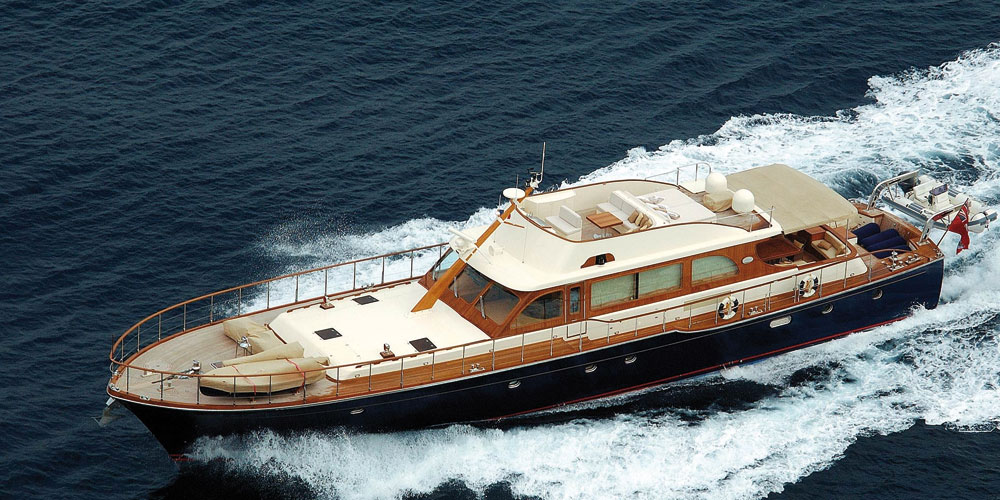During the early 1900s, wealthy New Yorkers, magnates of industry and finance, of commerce and of transportation saw in Long Island, the long strip of land looking onto the lively city of New York, the ideal place to build their homes. Immense and luxurious mansions with big parks flourished starting from the beginning of the century and particularly during the 1920s, creating the Gold Coast, a place which symbolized the enormous rise in wealth. The islands and other country locations were becoming the favored residential areas of the affluent families, these places were far from the metropolitan chaos and near the exclusive golf and polo clubs.
Characteristic yachts, later named Fast Commuters, transported upper middle class celebrities from Long Island to Manhattan, creating a new phenomenon of luxury commuting which quickly became the rage.
This tendency became widespread at the beginning of the 1920s as never before. Rapid and legendary, these yachts glided over the waters from the nearby residences to the wharfs of the City. Every morning a small fleet entered the port to moor at the New York Yacht Club.
The yachts thus called Fast Commuters were designed to fulfill the desire of the most privileged Americans who used them to commute from their homes along the river or the coast to their offices in the City. This luxury sea commuting came at the exact historic moment in which the subways and streets above were crowded by the great masses of workers in Manhattan.
For a least 7 months a year, from the early morning hours businessmen and industrialists could be seen boarding their fast commuters which brought them to their destination at a speed of over 20 knots. The commute lasted one hour and thirty or forty minutes giving the possibility to have breakfast, change clothes, read the mail and the daily newspapers. The luxury and exclusiveness of the railroad carriage was no longer comparable to the privacy and perfection of the Commuters.
The crew on board the Fast Commuters was particularly limited with respect to the other vessels: a Captain, a ship's engineer, a sailor and a steward were sufficient in order to guarantee the safety and the comfort of the guests.
Warm summer days were the best time to make the most of the deck. What better place for a business meeting if not on board a luxurious vessel while enjoying a good cigar immersed in the gentle sea breeze.
It was during the Roaring 20s that this category of vessels established its distinctive personality to the point of becoming a true social status symbol which distinguished those who had achieved success in the business world. Among them: Harold Pratt of the Standard Oil Company, William Vanderbilt Jr., grandson of Cornelius Vanderbilt founder of the railroad and marine transport empire in New York, Marshal Field III, heir to the great American department store of the same name, Harry Guggenheim, heir to the vast mineral resources in Mexico, and John Pierpont Morgan Jr., son the banker and financier who founded General Electric. The last scion mentioned, who was also a banker, had a determinant role in loaning the money to fund World War I. Among other things he was for many years the president of the New York Yacht Club and a boat enthusiast. He had more than one motoryacht, one of which was the Navette which was 35 mt. in length while the average boat of its category was between 12 and 22 mts. In the following decades the Fast Commuter remained the boat of the American upper classes as is evidenced by the Marlin, a 17 meter boat bought by the Ford family in 1930 and subsequently sold to the Kennedy family in 1952. These were the boats which belonged to those American who had contributed to the growth of the economic empire of a great nation. The Fast Commuter is elegant by definition, its style continues to find numerous followers today among the tycoons and high profile representatives of the industrial intelligentsia on an international level.
In addition, there are legends which tell the story of how some of the Commuters were involved in contraband activity during the period of prohibition. Cigarette was one of these, owned by the gangster Valentine Higgins who escaped on Valentine's Day in 1924 after a Coast Guard chase which led to his arrest for alcohol contraband.
Despite the fact that other forms of transport have become popular in the last decade such as private jets and helicopters, the fascination of sailing on board a traditional vessel remains an extraordinary experience.
